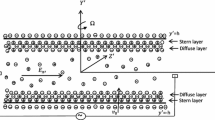Abstract
The primary objective of the paper was to present the design and analysis of an instrument to measure the heat convection coefficient h on the endothelial surfaces of arteries and veins. An invasive thermistor probe was designed to be inserted through the vessel wall and positioned on the endothelial surface. Electrical power was supplied to the thermistor by a constant temperature anemometry circuit. Empirical calibrations were used to relate electrical measurements in the thermistor to the h at the endothelial surface. As the thermal processes are strongly dependent on baseline blood temperature, the instrument was calibrated at multiple temperatures to minimise this potentially significant source of error. Three different sizes of thermistor were evaluated to optimise accuracy and invasiveness, and the smallest thermistors provided the best results. The sensitivity to thermistor position was evaluated by testing the device at multiple locations, varying both depth of thermistor penetration and position along the vessel. Finally, the measurement accuracy of the instrument was determined for the range of h from 430 to 4200 W m−2K, and the average error of the reading was 4.9% for the smallest thermistor. Although the instrument was designed specifically for measurements in the portal vein to obtain useful data for current numerical modelling, the device can be used in any large vessel.
Similar content being viewed by others
References
Barozzi, G. S., andDumas, A. (1991): ‘Convective heat transfer coefficients in the circulation’,J. Biomech. Eng.,113, pp. 308–313
Browing, P. D. (1992): ‘Hepatic ablation with use of radiofrequency electocautery in animal model’,J. Vasc. Interv. Radiol.,3, pp. 291–297
Bruun, H. H. (1995): ‘Hot wire anemometry: principles and signal analysis’ (Oxford University Press Inc., New York, USA, 1995)
Craciunescu, O. I., andClegg, S. T. (2001): ‘Pulsatile blood flow effects on temperature distribution and heat transfer in rigid vessels’,J. Biomech. Eng.,123, pp. 500–505
Charm S., Paltiel B., andKurland, G. S. (1968): ‘Heat transfer coefficients in blood flow’,Biorheology,5, pp. 133–145
Curley, S. A., Izzo, F., Delrio, P., Ellis, L. M., Granchi, J., Vallone, P., Fiore, F., Pignata, S., Banielle, B., andCremona, F. (1999): ‘Radiofrequency ablation of unresectable primary and metastsic hepatic malignancies: Results in 124 patients’,Ann. Surg.,230, pp. 1–8
Dos Santos, I., Shah, J., Da Rocha, A. F., Webster, J. G., andValvano, J. W. (2003): ‘An instrument to measure the heat convection coefficient on the endocardial surface’,Physiol. Meas.,24, pp. 321–335
Fitzgerald, T. J., Catipovic, N. M., andJovanovic, G. N. (1981): ‘Instrumented cylinder for studying heat transfer to immersed tubes in fluidized beds’,Ind. Eng. Chem. Fund.,20, pp. 82–88
Fujita, H., Ohhashi, T., Yamada, M., andWatanabe, K. (1993): ‘A thermistor anemometer for low flow measurements’,IEEE Trans. Instrum. Meas.,44, pp. 779–782
Gray, H. (1918): ‘Anatomy of the human body’ (Lea & Febiger, Philadelphia, 1918)
Goldberg, S. N., Hahn, P. F., Tanabe, K. K., Mueller, P. R., Schima, W., Athanasoulis, C. A., Compton, C. C., Solbiati, L., andGazelle, G. S. (1998): ‘Percutaneous radiofrequency tissue ablation: does perfusion-mediated tissue cooling limit coagulation necrosis?’,J. Vasc. Interv. Radiol.,9, pp. 101–111
Haemmerich, D., Staelin, S. T., Tsai, J. Z., Tungjitkusolmun, S., Mahvi, D. M., andWebster, J. G. (2002): ‘Finite element analysis of hepatic multiple probe radio frequency ablation’,IEEE Trans. Biomed. Eng.,48, pp. 836–842
Haemmerich, D., Wricht, A. W., Mahvi, D. M., Lee, F. T. Jr, andWebster, J. G. (2003): ‘Hepatic bipolar radiofrequency ablation creates coagulation zones close to blood vessels: A finite element study’,Med. Biol. Eng. Comput.,41, pp. 217–323
Incropera, F. P., andDewitt, D. P. (1996): ‘Fundamentals of heat and mass transfer’ (Wiley, New York, USA, 1996)
Kostka, M., andRam, V. R. (1992): ‘On the effect of fluid temperature on hot wire characteristics. Part1: Results of experiments’,Exp. Fluids,13, pp. 155–162
Livraghi, T., Goldberg, S. N., Monti, F., Bizzini, A., Lazzaroni, S., Meloni, F., Pellicano, S., Solbiati, L., andGazelle, G. S. (1997): ‘Saline enhanced radio frequency tissue ablation in the treatment of liver metastases’,Radiology,202, pp. 205–210
Lu, D. S., Raman, S.S., Vodopich, D.J., Wang, M., Sayre, J., andLassman, C. (2002): ‘Effect of vessel size on creation of hepatic radiofrequency lesions in pigs: Assessment of the ‘heat sink’ effect’,Am. J. Roentgenol.,178, pp. 47–51
McGahan, J. P., Brock, J. M., Tesluk, H., Gu, W. Z., Schneider, P., andNath, S., Lynch, C. III, Whayne, J. G., andHaines, D. E. (1993): ‘Cellular electrophysiological effects of hyperthermia on isolated Guinea pig papillary muscle: Implications for catheter ablation’,Circulation,88, pp. 1826–1831
Neeman, N., andWood, B. J. (2002): ‘Radiofrequency ablation beyond the liver’,J. Vasc. Interv. Radiol.,5, pp. 156–163
Oliveira, A., Freire, R. C. S., andDeep, G. S. (1997): ‘Compensation of the fluid temperature in hot-wire anemometry’,IEEE Instrum. Meas. Technol. Conf. pp. 1377–1380
Patterson, E. J., Scudamore, C. H., Owen, D. A., Nagy, A. G., andBuczkowski, A. K. (1998): ‘Radiofrequency ablation of porcine liver in vivo: Effects of blood flow and treatment time on lesion size’,Ann. Surg.,227, pp. 559–565
Rahman, A. A., Tropea, C., Slawson, P., andStrong, A. (1987): ‘On temperature compensation in hot wire anemometry’,J. Phys. E Sci. Instrum.,20, pp. 315–319
Ram, V. R. (1992): ‘On the effect of fluid temperature on hot wire characteristics. Part 2: Foundations of a rational theory’,Exp. Fluids,13, pp. 267–278
Sapareto, S. A., andDewey W. C. (1984): ‘Thermal dose determination in cancer therapy’,Int. J. Radiat. Oncol.,10, pp. 787–800
van Heiningen, A. R. P., Mujumdar, A. S., andDouglas, W. J. M. (1976): ‘On the use of hot film and cold film sensors for skin friction and heat transfer measurements in impingement flows’,Lett. Heat Mass Transf.,3, pp. 532–528
Valvano, J. W. (1985): ‘Thermal conductivity and diffusivity of biomaterials measured with self-heated thermistors’,Int. J. Thermophys.,3, pp. 301–311
Author information
Authors and Affiliations
Rights and permissions
About this article
Cite this article
Shah, J., dos Santos, I., Haemmerich, D. et al. Instrument to measure the heat convection coefficient on the endothelial surface of arteries and veins. Med. Biol. Eng. Comput. 43, 522–527 (2005). https://doi.org/10.1007/BF02344735
Received:
Accepted:
Issue Date:
DOI: https://doi.org/10.1007/BF02344735




